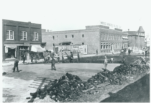A home on Civvy Street
By Medicine Hat News on May 12, 2018.
As the Second World War wound down, troops began returning from overseas, eager to return to civilian life, settle down and raise a family. It was the beginning of the baby boom but there was a problem: a housing shortage! The war effort had had priority for building materials and few houses were built. In Medicine Hat, the No. 34 Service Flying Training School, British Commonwealth Air Training Plan, had required housing for some 3,000 student pilots, trainers and support staff. In an obvious solution to the housing shortage, 10 “hutments” at the airport were acquired by the city, converted to civilian housing and families began moving in by November 1945. There was also discussion by council of converting the prisoner-of-war camp buildings to civilian housing and even whether use of chicken coops as housing should be allowed! Meanwhile, Wartime Housing Limited (later Canadian Mortgage and Housing Corporation) built tens of thousands of affordable housing units across Canada during and after the war, for munition workers and returning veterans and their families. At first, they could only be rented for $25-$30 per month but were later (from 1951) sold for $2,800-$4,200 with low mortgage rates. In Medicine Hat, the first 150 units were erected without basements, resulting in complaints of cold floors and frozen pipes. In March 1949 another batch of 100 homes, with basement, furnace and built-in bathtub, was officially opened. Grants were later provided to add basements under those houses without. The houses were built to standard plans and were paragons of efficient design and use of materials. A typical design would be a rectangular plan, storey-and-a-half semi-bungalow to make use of attic space, with no frivolous roof overhangs. One such story is that of 68 11th St. SW. Almer Mast had served with the South Saskatchewan Regiment as a transport/supply driver. He landed in France on July 8, 1944, advanced through Belgium into Holland, and was discharged in Weyburn in 1946. He rejoined his wife Lois and son David in Regina and moved to Fourth Street S.E. in Medicine Hat where son Paul was born. In 1948, they found lodging in the airport hutments where another son, Reid, was added to the family. In August 1949 Almer signed a lease for $37.50 per month for the house on 11th Street. Having proven that he could pay rent, and therefore meet mortgage payments, the Mast family acquired the house in 1954. A kitchen addition, porch and carport were added to the house between 1959 and 1966. Almer retired from the Police Service in 1980 and after he passed away in 1994, the house was sold by Lois a few years later. Today, some of these wartime houses have disappeared but many still exist, often renovated with changes and additions to the point that the original design is obscured. It’s worth a walk on the Hill on a sultry summer evening to see how many you can spot! Malcolm Sissons is the Chair of the Heritage Resources Committee. Research for this column was conducted by committee member Earl Morris. Appreciation is expressed to Paul Mast for his contribution of details and documents. 8-7




